- Quick Read
- Deep Read ( 7 Min. )
In Today’s Issue
- Stay or go? Bombarded by Israel, Gazans make anguished choice.
- With hostages’ fate uncertain, Israeli families cling to hope
- College campuses wrestle with Israel-Hamas war
- Why Poland’s ruling party is now criticizing Ukraine
- NASA’s latest mission targets a metal-rich asteroid
- Risk, resolve, and the courage to help kids connect
Monitor Daily Podcast
- Follow us:
- Apple Podcasts
- Spotify
- RSS Feed
- Download
TODAY’S INTRO
Unraveling Iran’s role in Hamas attack
As the scale and significance of the surprise Hamas raid against Israel become clearer, questions are being raised about Iran’s role. Might the Islamic Republic’s long-standing antipathy toward Israel lead to a broader and even more destructive regional fight?
During a recent visit to Lebanon, I was surprised by the determination of veteran Hezbollah fighters to take on Israel directly. The militant movement is backed by Iran and is far, far more militarily capable than Hamas. The fighters described their eagerness to take part in an inevitable next and “final battle” against Israel – targeting airports, barracks, and bases, and seizing large parts of territory.
As I explored further, however, it became clear that Hezbollah’s leadership had recently taken multiple steps to de-escalate – to ensure that high-stakes events with Israel never spiraled into war. Likewise, analysts noted that the decision for a Hezbollah-Israel war would be made by Iran.
American and Israeli officials have stated they see no evidence of a direct Iranian role in the Hamas assault. Iran’s supreme leader Ayatollah Ali Khamenei this week denied any role. Aware of the risks of a broader conflagration, leaders on all sides appear to have little appetite for one.
Iran is already grappling with widespread internal unrest and a dismal economy crushed by U.S.-led sanctions. It has eased back its nuclear program – in an apparent unwritten agreement with Washington – and dabbled in reconciliation with Arab neighbors.
In that context, it is noteworthy that Hezbollah did not launch its own assault from the north. In the first few hours of Hamas’ offensive, Israel’s intelligence and military were clearly knocked off balance – a moment Hezbollah could have taken advantage of.
It reminds me of an incident 15 years ago, when an Israeli offensive in Gaza killed 1,400 Palestinians. Iranian recruits hungry for revenge showed up at an airport in Tehran, ready for battle. In the end, someone from the office of archconservative President Mahmoud Ahmadinejad had to go to the airport. His message: Go home.
Share this article
Link copied.

Help fund Monitor journalism for $11/ month
Already a subscriber? Login

Monitor journalism changes lives because we open that too-small box that most people think they live in. We believe news can and should expand a sense of identity and possibility beyond narrow conventional expectations.
Our work isn't possible without your support.
Stay or go? Bombarded by Israel, Gazans make anguished choice.
Caught in the middle of the Hamas-Israel war, and with opposing orders from the combatants, 1.1 million civilians in northern Gaza must decide whether safety means leaving their homes. Our reporter had to make the agonizing choice.

-
By Hind Khoudary Contributor
-
Fatima AbdulKarim Contributor
Should I stay or should I go? Can I find a way out? Is anywhere safe?
As Israel bombarded the Gaza Strip Friday and gave 1.1 million Gazans a 24-hour ultimatum to evacuate to the southern end of the besieged coastal enclave, these frantic questions consumed Gazans, with no clear answers – and life-or-death consequences.
In Gaza City, a sleepless night of bombardment and rumors gave way to a morning of frantic second-guessing and scrambling for transport. Hamas told Gazans to stay put, and the United Nations requested that Israel rescind the decision, calling it both “impossible” and “devastating.”
But those who could Friday packed into cars with little more than the clothes on their backs and drove out of Gaza City. Among them was Monitor reporter Hind Khoudary.
“Because we left early, we made it to Deir al-Balah in 10 minutes,” she writes. “But now there are lines of cars to get out of Gaza City.
“Although Israel told us Deir al-Balah would be safe, within hours of our arrival a house was struck near us. ... I wished I had the time to ... say one last goodbye to my family house, in case it is bombed before I can return.”
Stay or go? Bombarded by Israel, Gazans make anguished choice.
Should I stay or should I go? Can I find a way out? Is anywhere safe?
As the Israeli military continued its bombardment of the Gaza Strip Friday and gave 1.1 million Gazans a 24-hour ultimatum to evacuate to the southern end of the besieged coastal enclave, these frantic questions consumed Gazans, with no clear answers – and life-or-death consequences.
In Gaza City, a sleepless night of bombardment and rumors gave way to a morning of frantic second-guessing and scrambling for transport as Israel called on Palestinians to vacate to south of Wadi Gaza, a dividing waterline in the center of the strip.
Hamas told Gazans to stay put, and the United Nations requested that Israel rescind the decision, which would create the largest single forced displacement the Middle East has seen in decades, calling it both “impossible” and “devastating.”
But those who could Friday packed into cars with little more than the clothes on their backs and drove out of Gaza City.
A steady stream of vehicles along the coastal road leading south from Gaza City midday became an afternoon traffic jam.
“People are packed in the streets, even evacuating on donkey carts,” says Sara al-Saqqa, a surgeon at Al Shifa Hospital. The facility had been one of the lone refuges in the city, and had hosted thousands seeking shelter from airstrikes amid the weeklong bombardment campaign that followed Hamas’ attack on Israel last Saturday.
“Everyone is fleeing. I saw people evacuating; I could not even enter the hospital,” Dr. Saqqa says.

Yet still tens of thousands remained in Gaza City, without cars, fuel, or a destination or acquaintance to stay with in southern Gaza.
In response to the Hamas assault, which killed 1,300 Israelis, mostly civilians, Israel mounted a massive and relentless bombing campaign that had killed 1,799 Gazans as of Friday, leaving no neighborhood untouched and sparking a humanitarian crisis of enormous proportions.
As of late Thursday, before the Israeli ultimatum, 423,378 people had already been displaced by the six days of conflict in the 140-square-mile strip, the U.N.’s Office for the Coordination of Humanitarian Affairs said Friday.
On Friday, Gaza City residents received airdropped flyers in Arabic purporting to be from the Israeli army with a map of Gaza and an arrow pointing south, warning, “Gaza City has become a battlefield. You are to evacuate your home immediately and head to the south of Wadi Gaza.”
“Terrorist organizations have launched a war against the state of Israel,” the flyer said, a copy of which was provided to the Monitor. “For your safety and security, do not return to your homes until further notice from the Israel Defence Forces.”
Hamas, the militant group that controls the strip, urged otherwise.
“We tell the people of northern Gaza and from Gaza City, stay put in your homes, and your places,” Eyad al-Bozom, spokesperson for the Hamas Interior Ministry, was quoted by Reuters as saying in a press conference at Al Shifa early Friday.
“By carrying out massacres against the civilians, the occupation wants to displace us once again from our land,” he said, dismissing the warnings as a “disgusting psychological war.”
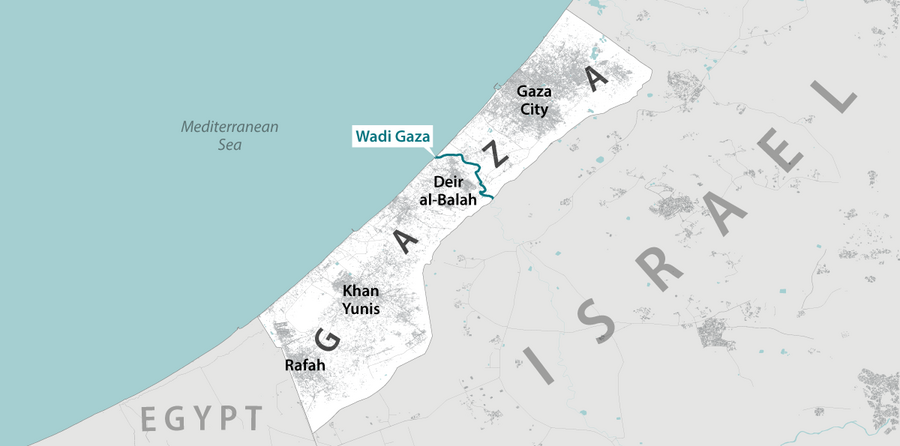
OpenStreetMap
The shortages of electricity and fuel, as well as disruptions to the communications network, began to affect Palestinians across the territory, with most Gazans plunged into darkness Thursday evening, without electricity for mobile phones. Israel said the cutoffs were intended to isolate an enemy that was still firing rockets into Israel, yet they were also preventing Gazans from receiving information or reaching what was supposed to be safer territory.
Hind Khoudary escapes with her family
After my third sleepless night on a hospital floor at Al Shifa, I had to make the decision: Do I stay in Gaza City or go south? Do I go with my mother to Rafah, or to Deir al-Balah with my husband, to what was supposed to be relative safety?
At 10:41 a.m., my husband and I, my in-laws, my brother-in-law, sister-in-law, and their daughter, Loli, piled into the car to stay with family friends in the village of Deir al-Balah, 7 miles south of Wadi Gaza.
With only minutes to spare before our planned departure, I grabbed my laptop, phone chargers, my ID, and a bag my mother packed for me.
I stopped by a pharmacy for treatment for an infection from a deep cut in my leg; all they could give me was some gauze.
“We barely have medical supplies; four rolls of gauze is enough,” the pharmacist tells me.
In Gaza City, many gas stations were shuttered. I saw several people begging station managers for fuel.
My husband found one of the last gas stations still open, but the attendant could only provide us with 50 shekels’ ($12.57) worth of fuel – about 8 liters (2.1 gallons) – as part of a rationing cap to distribute fuel to as many people as possible.
Yet many people we know do not even have cars; cars have burned in the missile strikes. Others simply do not know anyone in southern Gaza to stay with. Others still prefer to stay rather than be internally displaced.

My aunt told me she would prefer dying at home, surrounded by her children and grandchildren, than evacuating. This is why thousands are staying put in Gaza City, despite the danger.
Aneel, one of many frantically trying to find a way out, was stranded in Tal al-Hawa, a neighborhood in southern Gaza City. She had been evacuated from her home in Shuja’iyya, east of the city center, after a missile strike earlier this week.
“We can’t find a car to take us to the south; there are no cars and there is no one to take us,” she told my mother in an urgent phone call.
The coastal road leading out from Gaza City to the south, the road farthest from the barrier wall, was covered in dust and cracked from missile strikes. Because we left early, we made it to Deir al-Balah in 10 minutes. But now there are lines of cars to get out of Gaza City.
Although Israel told us Deir al-Balah would be safe, within hours of our arrival a house was struck near us. Hours after we made the journey, three cars carrying families heading south reportedly were struck by Israeli missiles in Wadi Gaza.
I wished I had had the time to grab my favorite blanket from home, and say one last goodbye to my family house, in case it is bombed before I can return.
Health care battle
The U.N. and international humanitarian organizations warned it was impossible to evacuate vulnerable and elderly Gazans and hospital patients from northern Gaza, many of whom rely on life support and mechanical ventilators.
“There are severely ill people whose injuries mean their only chances of survival is being on life support,” said World Health Organization spokesperson Tarik Jasarevic. “Moving these people is a death sentence. Asking health workers to do so is beyond cruel.”
The order to evacuate has proved yet another crisis for local health care workers in Gaza facing an uphill battle.

Palestine Red Crescent Society spokesperson Nebal Farsakh described the situation as “catastrophic,” with hospitals overflowing with patients, medical supplies dwindling, electricity shortages widespread, and health centers flooded with citizens seeking shelter. Paramedics brave airstrikes, and several have been killed in the weeklong conflict.
Over the past week, hospitals have emerged as makeshift shelters as thousands of Palestinian civilians flocked to hospitals in northern Gaza such as Al Shifa and Al Quds, out of the belief that the health centers are now the only safe areas Israel will not strike.
With Israel’s ultimatum Friday, it is unclear whether those safe havens will remain.
Yet despite the challenges and the Israeli ultimatum, the Palestine Red Crescent Society says their health care workers will not “turn their backs” on Gaza City and abdicate their responsibility.
“The decision has been made: We are not evacuating. We are not turning back on our duty. We will stay in our main office in Gaza,” Ms. Farsakh says.
“We cannot evacuate the patients; most of them are not in condition for transfer right now. Al Quds hospital is crowded with displaced civilians, our team, and relocated paramedics,” she adds.
Medhat Abbas, director general of Gaza’s Health Ministry, declared a “collapse” of Gaza’s health system, with overflowing hospitals struggling to treat injured civilians and unable to evacuate them.
“The health sector completely collapsed,” Dr. Abbas says in a phone call from Gaza City cut short by communications disruptions. “People are sleeping on the ground in hospitals, which are overflowing with displaced civilians next to bodies and the injured.”
Hind Khoudary reported from Gaza City and Deir al-Balah, and Fatima AbdulKarim reported from Ramallah. Special correspondent Taylor Luck contributed to this report from Amman, Jordan.

OpenStreetMap

With hostages’ fate uncertain, Israeli families cling to hope
Hamas is believed to be holding more than 150 hostages in Gaza after Saturday’s attack. Finding them and securing their release poses an unprecedented challenge for Israel, which is poised for a major ground offensive.
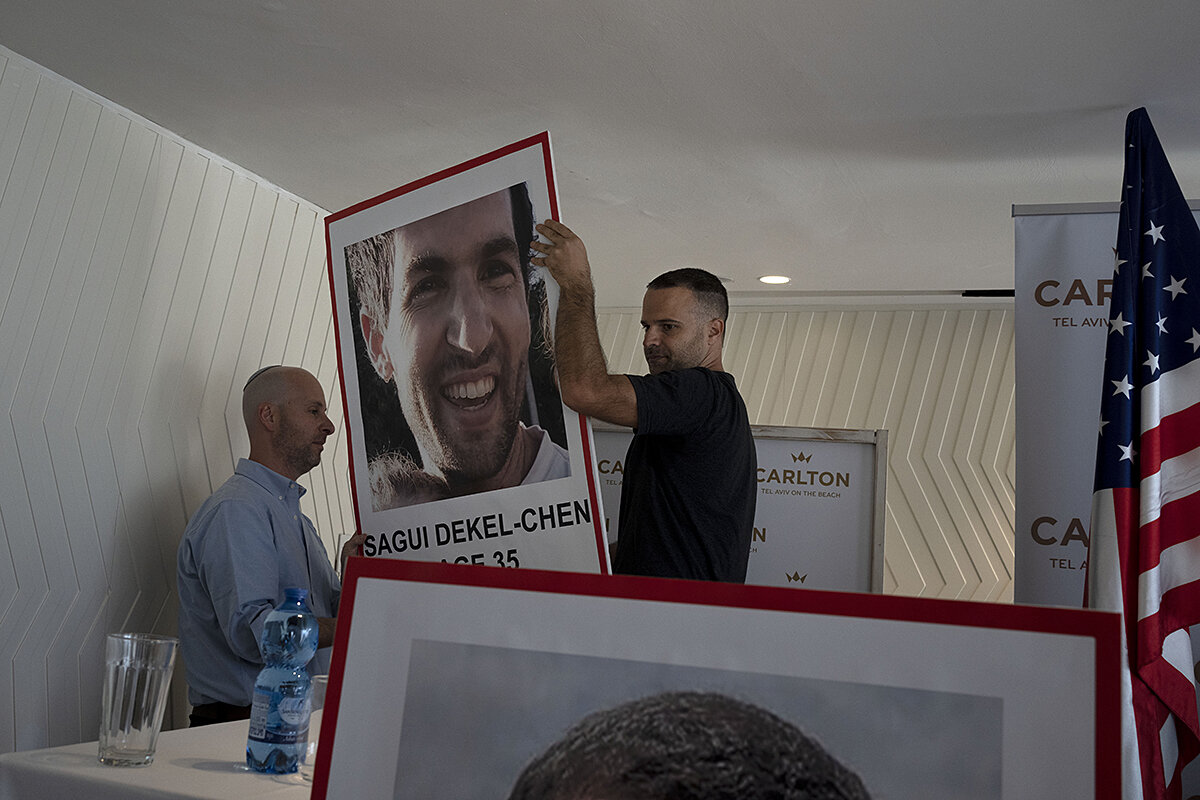
- Quick Read
- Deep Read ( 5 Min. )
Gur Tovbin woke up at 9:30 a.m. on Oct. 7, opened Instagram, and started seeing videos of the Hamas assault. Then his best friend’s mom called.
At 7 a.m., Nir Forti had messaged his sister, saying everything was fine at the desert rave party he was attending. His mom, who had heard that Hamas militants had attacked the party, hadn’t heard anything since. No one had. They still haven’t.
But for the past week, Mr. Tovbin has been part of a group of friends scouring the internet for evidence of Mr. Forti’s fate. And they are part of only one among many such groups.
Hamas is believed to be holding as many as 150 hostages in its Gaza hideouts. Israeli Prime Minister Benjamin Netanyahu promised parliament on Thursday evening that “we will not slacken in the effort to bring them back home.” But he has kept any plan he has very close to his chest.
A prisoner swap might resolve the problem. Or Israeli special forces might attempt to rescue the hostages. But for the time being, the worst thing is not knowing.
Says Yonatan Lulu Shamriz, whose brother has disappeared, “He is missing, but we pray he is only kidnapped.”
With hostages’ fate uncertain, Israeli families cling to hope
Gur Tovbin woke up at 9:30 a.m. on Saturday, opened Instagram, and started seeing videos of the Hamas assault. Then his best friend’s mom called.
At 7 a.m., Nir Forti had messaged his sister, who was concerned by reports of a Hamas attack on the desert rave party he was attending. He was okay, he told her.
No one has heard anything from him since, his mom says.
Mr. Tovbin had met Mr. Forti in kindergarten. They went through high school and military service together, and lived on the same kibbutz. “This is like the most loved person on Earth,” says Mr. Tovbin.
So Mr. Forti’s friends banded together on social media to scour videos, share information, and try to get press attention.
“Our government right now is so weak,” says Mr. Tovbin. “They are basically in shock.”
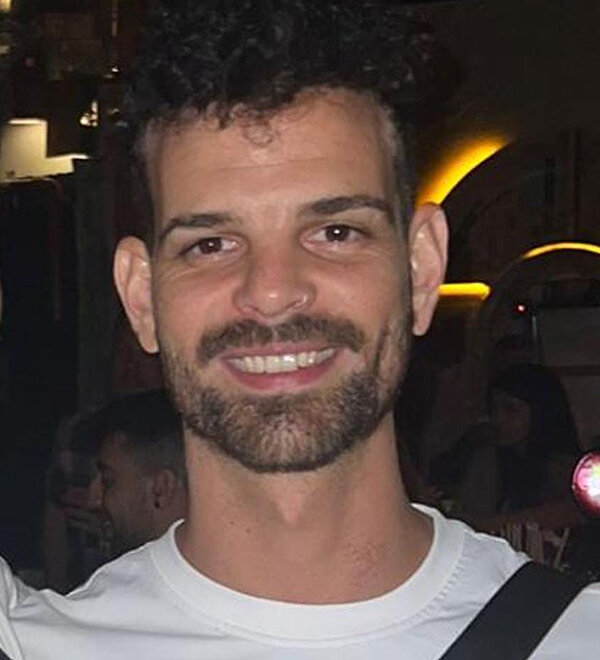
Prime Minister Benjamin Netanyahu, whose own brother was killed in a 1976 rescue operation of a hijacked Israeli flight, embraced the hostages’ families in his speech to the Israeli Knesset last night and said his point person is “in constant contact” with them.
“We will not slacken in the effort to bring them back home,” he said. His office declined to elaborate.
Where are they?
Gaza militant groups are believed to be holding more than 150 hostages. Among them are grandmothers and toddlers, a woman whisked away on a motorbike, and a captive covered in a sheet and driven off in a golf cart. Some are foreigners, including up to 21 Americans.
While Israel has retrieved hostages and the remains of its citizens in the past, the scope and complexity of this hostage crisis is beyond anything the country has faced before. That poses a strategic challenge as the Israeli military prepares for a major ground offensive in Gaza.
Militants are likely hiding the hostages in different locations – possibly including underground tunnels – and are already threatening to execute them if Israel bombs civilian housing without prior warning.
The Red Cross has said it is in daily contact with Hamas, and stands ready to visit those held and facilitate communications between them and their families. Still, many experts say that attempts by special forces to rescue the hostages are the most likely outcome.
“I don’t know how you negotiate under these circumstances,” says Gershon Baskin, who shuttled between Hamas and Israel to secure the 2011 release of captured soldier Gilad Shalit, who had been held for five years in Gaza. “I think that there are very few if any options for getting the hostages out through an agreement.”

That has not dissuaded Qatar, which backs Hamas, from reportedly working on a deal by which the hostages could be swapped for 36 Palestinian women and children, according to a Reuters report based on an unnamed source. If Qatar was really serious, says Mr. Baskin, they would threaten Hamas leaders based there with deportation unless they secured a swap.
Hamas, which is thought to be only one of several groups holding the hostages, has demanded the release of the more than 8,000 Palestinian prisoners in Israeli jails in exchange for their safe return – including 559 serving life sentences for murdering Israelis.
Since Israel withdrew its troops and settlers from the Gaza Strip in 2005 and Hamas won elections the following year, the Israeli government has come under international criticism for largely sealing off the territory. Hamas has fought five wars with Israel since 2006, and repeatedly lobbed missiles across the Gaza border into Israel.
“We pray he is only kidnapped”
But this latest militant attack is like something out of the ISIS playbook, says Mr. Baskin.
One initial challenge has been figuring out who exactly was kidnapped. Yonatan Lulu Shamriz, from the kibbutz Kfar Aza on the Gaza border, hasn’t heard from his younger brother, Alon Lulu Shamriz, since 10 a.m. on Saturday, when Alon messaged him that terrorists were about to enter his house. Yonatan told him that he was strong, and that he loved him. There was no response.
“He is missing but we pray he is only kidnapped,” says the elder Mr. Shamriz, whose neighbor was killed.
“What they did to us, what they did to babies and families – it’s unforgivable,” he says of the Palestinian attackers, adding that he had been a strong believer in coexistence. But now, while he says he would be “thrilled” if Palestinian civilians could escape to Egypt, the other side of Gaza’s southern border, he sees only one solution: “Gaza should be like a parking lot.”
Mr. Tovbin also doesn’t know for sure if his friend Mr. Forti was kidnapped or killed, but he has been working with others to find videos with any clue to his whereabouts. Some are even learning Arabic, or brushing up on what Arabic they knew, to aid in the search.

Others can be more certain that their loved ones were indeed abducted. More than 20 different people sent Yaniv Yaakov a video of his brother and his brother’s girlfriend being kidnapped from their bomb shelter in Nir-Oz, a small kibbutz of about 300 from which he says more than 70 people are missing. His brother’s children were also kidnapped from their mother’s house, she has confirmed.
“We really feel betrayed by our government, they didn’t keep us safe,” says Mr. Yaakov, who lives about an hour north outside Ashdod.
He has set up a “war room” in his bomb shelter, with two computers, and is working with his brother’s former wife to contact anyone who can provide more information and pressure the Israeli government and international community to keep the hostage issue front and center.
“I don’t think that our government or the world should focus on clearing the Hamas out of Gaza,” he says. “I think we should all concentrate on bringing [the hostages] home safe and sound.”
In the meantime, the effort to locate and rescue the hostages is giving friends and family a sense of purpose and solidarity.
“Definitely there’s a sense of coming together for a shared cause,” says Mr. Tovbin.

College campuses wrestle with Israel-Hamas war
Several universities drew criticism this week for muted responses to controversial student statements about the Hamas attack on Israel. Many students say they feel empathy for all and want to learn more about the conflict.

- Quick Read
- Deep Read ( 10 Min. )
-
Henry Gass Staff writer
-
Sarah Matusek Staff writer
-
Camilo Fonseca Staff Writer
-
Isa Meyers Staff writer
-
Mackenzie McCarty Staff writer
-
Isabel Wesman Staff writer
Hamas’ surprise attack on Israeli civilians over the weekend incited strong reactions on college campuses across the United States. As the conflict escalated to war and atrocities were coming to light, many students voiced often harsh judgments about responsibility and the conflict’s history. That ignited a firestorm and raised questions about the role of universities in addressing divisive issues and fostering critical thinking among students who are still working out moral and ethical views.
Polarization around the Israel-Palestine conflict has existed on U.S. college campuses for some time. Campus groups like Hillel International have been criticized for partnering with groups with ties to Israel’s government, while professors who have supported an academic boycott of Israel have been blacklisted.
The violence of the past week has flipped that dynamic on its head somewhat, with Israeli civilians the victims of horrific attacks. Combined with a genuine increase in antisemitism, polarization on campuses seems to have deepened right at a moment when empathy could be most widespread.
“If we truly believe in bringing about some peaceful resolution to this crisis, we have to acknowledge that violence occurs on all sides,” says Barry Trachtenberg, a professor of Jewish history at Wake Forest University.
College campuses wrestle with Israel-Hamas war

Hamas’ surprise attack on Israeli civilians over the weekend incited strong reactions on college campuses across the United States. As the conflict escalated to war and atrocities were coming to light, many students voiced often harsh judgments about responsibility and the conflict’s history. That ignited a firestorm and raised questions about the role of universities in addressing divisive issues and fostering critical thinking among students who are still working out moral and ethical views.
In statements that started to appear quickly after the deadly attack at a music festival and kibbutzim, in which more than 1,000 people were killed, several student groups did not mince words.
The Israeli “regime” is “entirely responsible for all unfolding violence,” declared a coalition of more than 30 student groups at Harvard University in an open letter on Saturday, Oct. 7. The next day, at the University of Virginia, Students for Justice in Palestine wrote that “the events ... are a step towards a free Palestine.”
The Harvard student letter in particular faced swift condemnation from inside and outside the university, including politicians who called on Harvard to condemn the attack and business leaders who demanded names so they could avoid hiring those students. Over the next few days, a coalition of school leaders responded with a statement that critics blasted as too weak, and Harvard President Claudine Gay followed up with an additional letter, and then a subsequent video, denouncing the “terrorist atrocities” and distancing the university from the student groups exercising their free expression.
Other universities extended statements of support to their school communities and offered education and dialogue on the complex, decadeslong hostilities between Israel and Hamas. Some decried the Hamas attack as terrorism, as has the United States. Ben Sasse, president of the University of Florida in Gainesville, was unequivocal: “I will not tiptoe around this simple fact: What Hamas did is evil and there is no defense for terrorism. This shouldn’t be hard,” he wrote, vowing to protect Jewish students on campus.

Since Saturday’s attack, Israel has cut off food, water, and fuel to Gaza, which has more than 2 million residents, and barraged the area with rocket attacks, killing more than 1,000 people. It has given 1.1 million civilians 24 hours to flee.
The firestorm of responses raises questions about the role of universities in tackling hard philosophical and ethical questions. It also comes at a time of rising antisemitism. In 2022, antisemitic incidents increased by 42% on campuses, the Anti-Defamation League reports, an even greater rate than the 36% increase in the U.S.
But for many years on college campuses “there has been great confusion on what is antisemitism and what is legitimate criticism of Israeli policies and the state of Israel,” says Atalia Omer, a professor of religion, conflict, and peace studies at the University of Notre Dame.
“There has been an increase in real antisemitism, but because of that conflation of Zionism and Judaism, it’s really hard to call it out when it’s real,” she adds.
A deep polarization around the Israel-Palestine conflict has existed on U.S. college campuses for some time, with Jewish student groups often feeling compelled – if not explicitly directed – to defend past Israeli military interventions against the Palestinians. Campus groups like Hillel International have been criticized for partnering with groups with ties to Israel’s government, and professors who have supported an academic boycott of Israel have been blacklisted.
But the violence of the past week has flipped that dynamic on its head somewhat, with Israeli civilians the victims of horrific attacks. Combined with a genuine increase in antisemitism, polarization on campuses seems to have deepened right at a moment when empathy could be most widespread.
“If we truly believe in bringing about some peaceful resolution to this crisis, we have to acknowledge that violence occurs on all sides,” says Barry Trachtenberg, a professor of Jewish history at Wake Forest University.
“Students should be allowed to disagree over politics,” he adds. “Israel can’t stand somehow apart from that, because if it does, then it puts us in this position of trying to regulate what can and cannot be said about a political entity.”
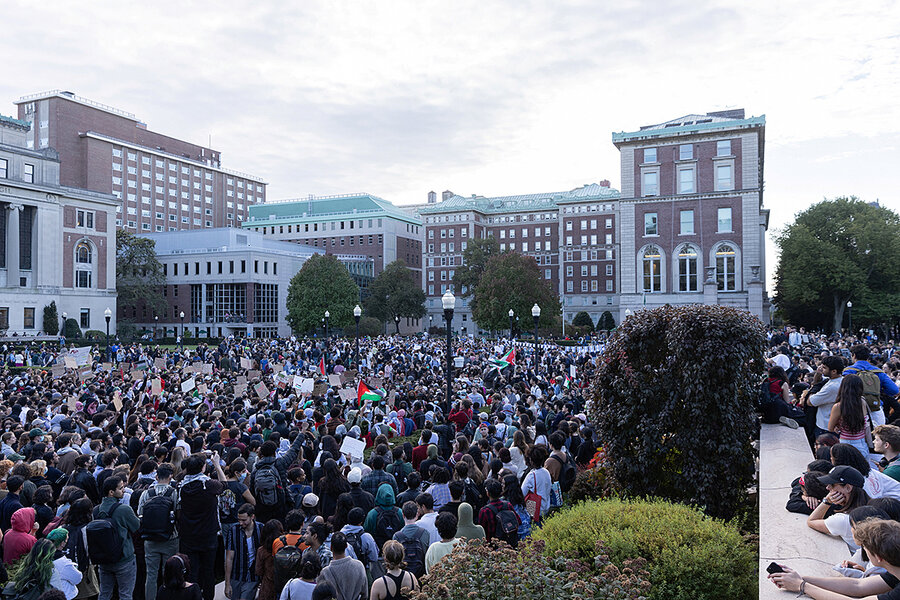
“Definitely getting polarized”
On Harvard’s campus, ongoing debate over the invasion has driven a deep wedge. “Campus is definitely getting polarized,” says freshman Sylvie Wurmser. “People are all trying to take a position, one way or the other.”
Law student Lea Kayali believes many media outlets and pro-Israel groups have seized on the Harvard student statement to launch “ad hominem attacks against Palestinians, and anyone who is within a 10-foot radius of supporting them.”
“What we’re seeing is the bad-faith interpretation of things that students have said, and of the statement in general,” says Ms. Kayali, who is Palestinian American, adding that sympathizers have credible concern for their safety on campus. Those students are only doing “what [students] are trained to do in academic settings: to point to structural systems of violence in order to make sense of the world around us,” she says.
Several students who spoke with the Monitor saw a van driving around campus displaying the faces and names of students expressing support for Palestine. A vigil organized by Harvard’s Palestine Solidarity Committee was canceled on Tuesday, reportedly due to security threats.
“It’s really disturbing that students have been targeted and doxxed and harassed on social media for expressing their personal views,” says Shashank Vura, a third-year Harvard Law student.
Media coverage has “skewed” public perception of Harvard’s student body, he believes, especially since the attitudes on campus are far from black and white. “The media is reporting as if the vast majority of students are pro-Hamas or pro-violence,” Mr. Vura says. “But I don’t think there is a single student here that supports that kind of violence.”
Jewish students, too, say they feel threatened, with an Ipsos survey finding that 57% of Jewish college students say they’ve either witnessed or experienced antisemitism this year. Gali Polichuk is a sustainability major at the University of Florida in Gainesville, which has the largest Jewish student population in the U.S. The UF senior, who is Jewish, visited Israel earlier this year and has family and friends there. She says Jewish students on campus have been on edge, fearful of antisemitic language and possible attacks since the Hamas invasion.
“It’s the collective feeling of knowing that the situation in Israel affects everyone here,” she says, adding that she empathizes with the Palestinian people. While she feels supported by her university administration in a way that Jewish students at other colleges do not, she says the pro-Palestinian activism on campus this week has created a climate of fear for Jews.
“I feel really sad about every single life that’s lost; I feel completely destroyed by it,” she says. “It doesn’t matter if it is Israeli or Palestinian – if it’s an innocent life, it’s an innocent life.”
Drizzly deliberation, and a need to learn
Under a blanket of gray clouds and a steady drizzle at the University of Texas at Austin, freshman Michael Lahti admits he doesn’t know very much about the conflict, but “it seems like a sad situation overall,” he adds. “Any war is sad.”
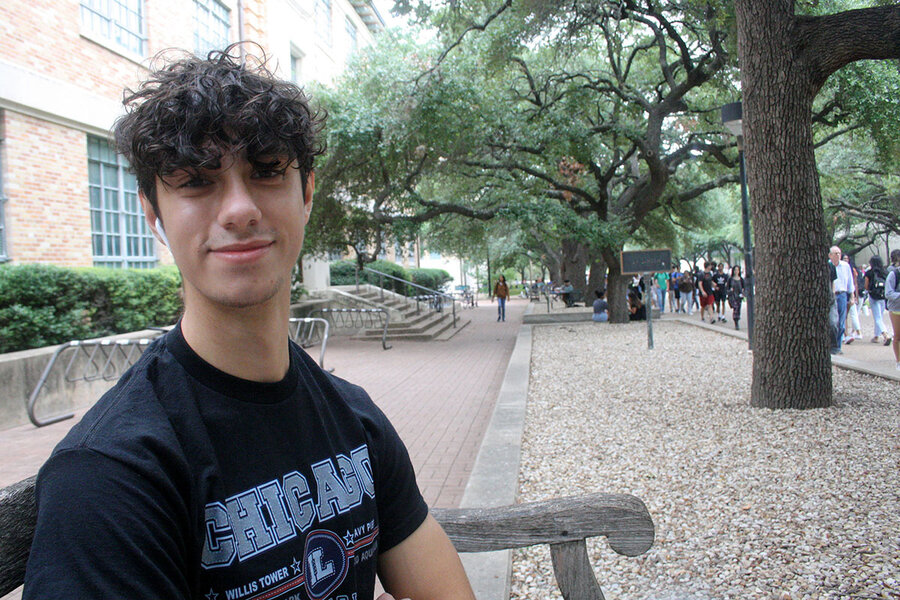
Eating lunch between classes, Alexis, a senior who didn’t want to give her last name, was surprised there hasn’t been more activity. Most of the conversations she’s had about it have been with her family. “To me, it was a terrorist attack,” she says.
But like many students on campus, she acknowledges there is a broader history to the conflict – a history with which she is unfamiliar.
The war has multiple defensible positions, says Laura Schwartz at American University.
“It’s an easy answer that terrorism is never OK,” says Professor Schwartz. “But ... there are people who arrive at college or arrive at work or in their lives and communities this week with a very limited understanding of this. And so you have to meet people where they are and find out, what more do we need to know? What do you need to learn about all of the people involved in this?” This type of respectful dialogue makes space for nuance and fosters greater understanding of complicated histories and ideas, she says.
Saws, a graduate student from the Middle East at the University of Texas, says she feels a responsibility to educate her peers about the conflict. On this drizzly Wednesday afternoon, she has been talking with her friend about it.
“No one wants war, but it didn’t start five days ago – it started 75 years ago,” she tells her friend. “Gaza has been under attack for decades,” adds Saws, who is Muslim and didn’t want to give her last name. “I don’t support killing innocents,” she adds, “but if you look at the numbers ... already hundreds of [Palestinians] have been killed” in retaliation.
Context and empathy
At the University of Colorado Denver, Andrew scrutinizes both Israel and Hamas. “I think they’re both wrong. They should stop attacking each other,” he says, walking through the downtown campus.
The first-year music student, who asked not to publish his last name for privacy reasons, has followed news of the atrocities via social media and livestreams by Fox News and CNN. He hopes the U.S. won’t further involve itself.
“I think we just need to focus on fixing our country before we go fixing the world,” he adds on the way to his dorm.
Later on campus, beneath an overcast sky that began to spit rain, several dozen people convene for a pro-Palestinian rally outside a building named for Israel’s only female prime minister, Golda Meir. “Resistance is justified when people are occupied!” the crowd chants in a call-and-response.
Nour Nsirat, a senior with Palestinian family ties, stands in solidarity. “This is genocide. It’s colonization,” says the student of human development and family relations about the Israeli blockade of and attack on Gaza.
She is matter-of-fact about the consequences of war: death. “I say that we can have empathy, but understand the need for Palestinians fighting back,” she says, adding that Israelis “started” the conflict.
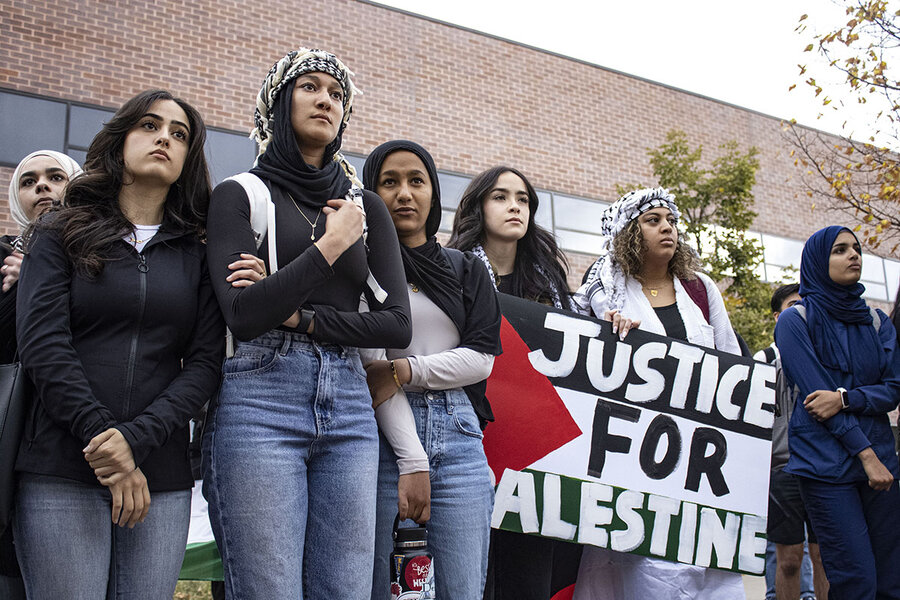
The years of polarization have baked in the dehumanizing reactions of recent days, says Dr. Omer, and they’ve made collective, unifying grief almost impossible. “There’s an inability to recognize the suffering and the loss and the pain of Israeli civilians,” she adds, “and on the other hand any contextualizing of Hamas and the attack [last weekend] as an outcry about the crimes against humanity happening right now in Gaza.”
Brett Riggs, a senior at UT Austin, has been following the conflict and talking about it with friends and co-workers, but he says he doesn’t know enough to declare who is right and who is wrong, who is an aggressor and who is a victim. Social media makes it even more confusing, he says.
“We used to not know everything that’s going on, but now we see everything,” he adds. But seeing isn’t understanding, he continues. “You don’t know the full story unless you’re there.”
A principle of dialogue, says Professor Schwartz, is to achieve understanding.
“Understanding and excusing are different. Empathy and agreement are different,” she says. “You can empathize with human beings and disagree with them. You can see your fellow discussant that you disagree with as a human being, having real feelings and disagree with him. And you can respect people without respecting every idea they hold.”
Common ground
On Boston College’s campus, there was one thing students agreed on: Celebrating death, as they had seen on social media, is appalling.
“Cheering on the deaths of real people, it’s just gross,” says Anna Pompa, a freshman.
“I’ve seen a lot of that,” said Molly, who is Jewish and didn’t want to give her last name.
“I do not condone what’s happening to Palestinians at all with the Israeli government, but I also don’t think it’s justifiable ... to kind of say that the killing of Israeli civilians and Jewish people is OK,” adds Molly, who says her family escaped the Holocaust.
At Brandeis – a university with deep Jewish roots – freshman Elise Legler is taking the time to prioritize her friends as they process the attacks, “just supporting [them], consoling them, making sure they’re OK.” She isn’t taking a side but recognizes the complexity of the issue at hand. “It’s important to prioritize human life,” she says. “That’s my stance.”
Students also point out the opportunity for bridge-building between Israeli and Palestinian supporters. “I have friends on both sides of the conflict,” says freshman Aodhan Kawakyu. “I also shouldn’t be saying ‘the two sides’ because it’s more than just two sides. ... It’s not just the military groups; it’s the civilians as well, and we can’t put blame on the civilians for living where they’re living.”
Fellow student Sree Dharmarha believes nobody should cheer about death, no matter how complex a region’s history. “The common ground here is that it’s both human lives. ... Civilian lives are being lost, and innocent people’s lives are being lost.”
In Boston, Kobe Cragg, a fourth-year student at Northeastern University, spent hours on the phone with his mom, trying to make sense of it all, and checking in on his Palestinian and Israeli friends to see how they are doing. He describes the violence in Israel and Gaza as an “absolute tragedy.”
The pyschology major believes empathy is achievable, even if it may be more difficult for people with close ties to the conflict. “I believe it’s possible to have empathy for anybody,” he says, adding that watching President Joe Biden’s live address moved him to tears. “I think with what’s happening right now, I understand the challenge of having empathy for one another’s sides.”

Why Poland’s ruling party is now criticizing Ukraine
If one European nation has stood by Ukraine in its war with Russia, it is Poland. But that partnership is under strain as Poland nears crucial national elections and parties try to take advantage of voters’ frustrations.
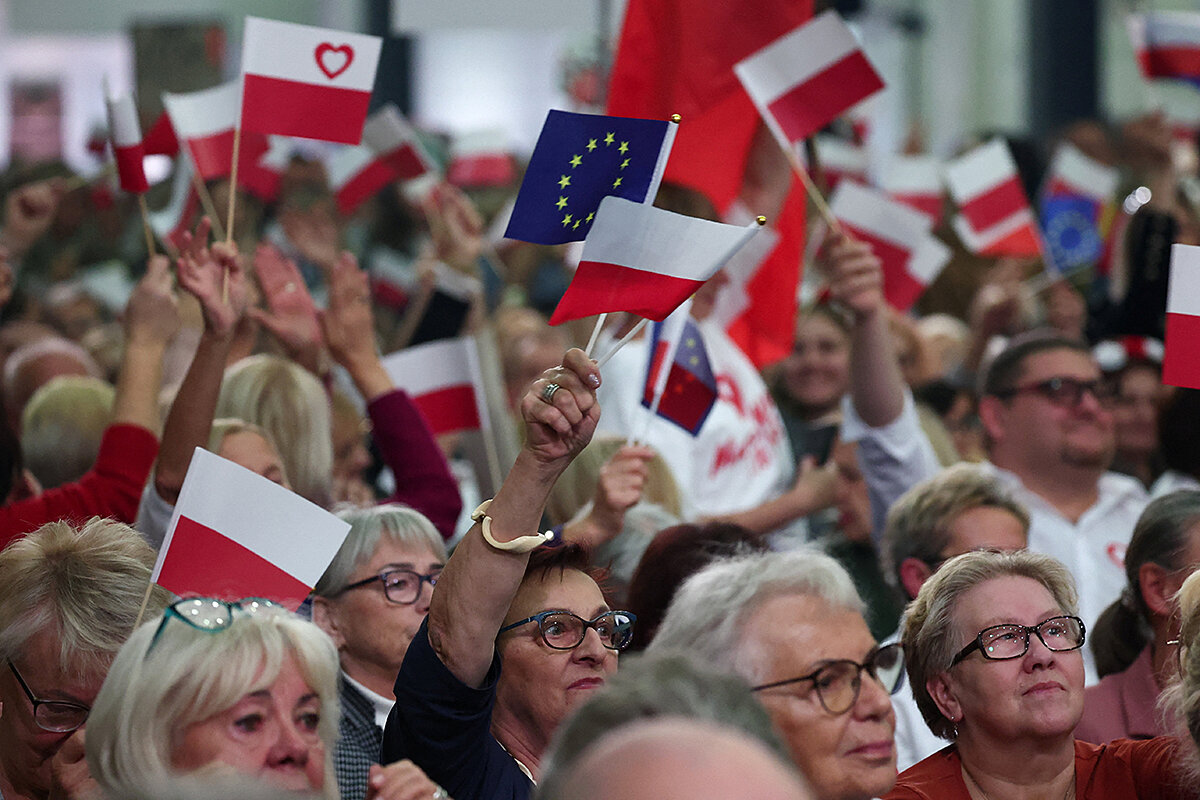
- Quick Read
- Deep Read ( 5 Min. )
When Russia invaded Ukraine in February last year, Poland was quick to come to Kyiv’s aid.
Despite a history of grievances with its eastern neighbor and a recent track record of antipathy, if not outright hostility, toward refugees, Warsaw became a diplomatic and military hub for Ukraine’s war effort and a haven for Ukrainians seeking safety from the fighting.
But national elections, like Poland’s parliamentary vote on Sunday, have a way of changing perspectives.
Amid squabbles over Ukraine’s grain shipments to the European market, Poland’s governing Law and Justice party has turned military aid to Ukraine and ongoing support for Ukrainian refugees into campaign issues in the upcoming elections. And the sharpness and frequency of acrimonious remarks exchanged between Warsaw and Kyiv have raised concerns from Brussels to Washington that the pro-Ukrainian Western consensus could unravel to the benefit of Moscow.
“This is severely damaging to the European-wide consensus and unity in Ukraine because every country in Europe is experiencing war fatigue,” says Zofia Kostrzewa of the European Council on Foreign Relations. “The U.S. is experiencing war fatigue. This is Poland, which has been perceived as Ukraine’s strongest ally. What kind of message does it send to others who are not so supportive?”
Why Poland’s ruling party is now criticizing Ukraine
When Russia invaded Ukraine in February last year, Poland was quick to come to Kyiv’s aid.
Despite a history of grievances with its eastern neighbor and a recent track record of antipathy, if not outright hostility, toward refugees, Warsaw became a diplomatic and military hub for Ukraine’s war effort and a haven for Ukrainians seeking safety from the fighting.
And Polish prognosticators on the threat Russia posed were able to tell the West, “We told you so” about a nation they have long seen as an existential threat.
But national elections, like Poland’s parliamentary vote on Sunday, have a way of changing perspectives.
Amid squabbles over Ukraine’s grain shipments to the European market, Poland’s governing Law and Justice party (PiS) has turned military aid to Ukraine and ongoing support for Ukrainian refugees into campaign issues in the upcoming elections. And the sharpness and frequency of acrimonious remarks exchanged between Warsaw and Kyiv have raised concerns from Brussels to Washington that the pro-Ukrainian Western consensus could unravel to the benefit of Moscow.
“This is severely damaging to the European-wide consensus and unity in Ukraine, because every country in Europe is experiencing war fatigue,” says Zofia Kostrzewa of the Warsaw office of the European Council on Foreign Relations. “The U.S. is experiencing war fatigue. This is Poland, which has been perceived as Ukraine’s strongest ally. What kind of message does it send to others who are not so supportive?
“The honeymoon is over,” she adds. “[All] this has started a more realistic rethink about what the relationship between the two countries will be.”

National politics gone international
Its no accident the right-wing Law and Justice chose “a secure future for Poles” as its campaign slogan. Poles have a lot of concerns related both directly and indirectly to Russia’s war on Ukraine. The ruling party promises to keep up support Ukraine, but not at the expense of Polish interests.
It is those interests that prompted the feud over Ukrainian grain in the EU market – a concern for multiple European nations due to the size of Ukraine’s grain production, but Poland was one of the few to implement a ban and refuse to lift it. Ukraine initiated a complaint against Poland with the World Trade Organization over the ban. Ukrainian President Volodymyr Zelenskyy escalated the diplomatic spat by implying in a speech at the UN that Poland was “feigning solidarity by indirectly supporting Russia,” deeply offending Warsaw.
“Zelenskyy’s speech from the UN in New York made a very bad impression,” says Michal Kacewicz, an expert and publicist at Belsat, a Polish television channel aimed at Belarus. “It was perceived in Poland as ingratitude and was condemned by virtually the entire political class.
Polish President Andrzej Duda, meanwhile, compared Ukraine to a “drowning man” that can drag others down with it. And the Polish prime minister announced a halt to weapon exports to Ukraine. The statement has been dialed back to clarify this meant no “new weapons” and that current contracts will be honored, but the damage was done. The foreign minister of Poland, like that of Hungary, skipped a historic gathering of Europe’s top diplomats in Kyiv this month.
The grain tiff plays directly to a key constituency of the ruling party: farmers. And while PiS’s largest challenger is the liberal Civic Coalition, led by former European Council President and Polish Prime Minister Donald Tusk, the ruling party also has to contend with Confederation, an anti-Ukrainian, far-right party that could both be a potential coalition partner and a direct competitor for conservative voters. Analysts say that such electoral calculations coupled with the grain issue – which portends a longer-term conflict if and when Ukraine joins the European common market – set the stage for the dispute with Kyiv.
“They will sacrifice everything just to win the elections and then try to reverse or make things right,” says Piotr Łukasiewicz, an analyst at the Polish think tank Polityka Insight. “That’s the mood among the PiS [politicians]. The relations were damaged between Ukrainians, Americans, and the European Union when it comes to Poland. ... It should take a heavy effort from the ruling party to restore the former good relations. For the opposition [if they win,] it will be easier.”

Fatigue, but not rejection
But while PiS lashed out at Ukraine hoping to win political points at home, it isn’t clear whether this will pay off in Sunday’s highly polarized vote.
A poll conducted by IBRiS indicated that 47.2% approved of Poland no longer arming Ukraine because “we are now arming ourselves with the most modern weapons.” Another 44.5% disapproved, while 8.3% gave no opinion. That stands in contrast to a December 2022 survey that showed 77.5% of respondents in favor of transferring weapons and armaments to Ukraine.
Support for Ukrainian refugees has waned as host-nation fatigue sets in. Robert Staniszewski from the University of Warsaw has carried out research that elucidate some of the reasons behind this downward trend. A June survey showed a 13% drop in the number of people who view Ukrainian refugees favorably. Some 39.4% of those who said their attitudes had changed for the worse, pointed to the “entitled attitude” of refugees. Still an overwhelming 85% of respondents said Poland should help Ukraine during the war.
“There is a fatigue,” says Dr. Łukasiewicz. “But support is still surprisingly high. It’s not like we became an anti-Ukrainian-refugee nation.”
And it seems unlikely that Poland will ever completely abandon Ukraine as long as Russia remains a common concern. A United Surveys poll conducted in May found 31% of Poles worry about a Russian attack on Poland. These concerns are mainly concentrated among supporters of the ruling party.
“The threat comes both from proximity to Ukraine, and the fear that given Russia’s belligerence, Putin’s desperate need to shore himself up, and a long history of past aggression, if Ukraine falls, Poland is next,” says Anna Grzymala-Busse, director of the Europe Center at the Freeman Spogli Institute at Stanford University.
For most Poles, Russia is not the immediate danger it once seemed, according to Dr. Łukasiewicz. “Poles believe that that there is no imminent danger for Poland,” he says. “The coalition works. We are buying stuff, heavy stuff. I don’t think there is a feeling right now that we are in the situation when Russia could invade Poland next, at least not in the next few years.”
Still, Poland has doubled its defense spending in 2023 and is overhauling its air defense system. “Poland truly believes that Russia will not stop at Ukraine, that it will come for Poland, just like it’s been doing for ... hundreds of years,” says Ms. Kostrzewa. “This historical memory is still very active for us.”

NASA’s latest mission targets a metal-rich asteroid
By sending a spacecraft on a journey of 2 billion miles, scientists hope to learn something about the core of our own planet. NASA’s mission to a metal-rich asteroid is about curiosity and creativity.

- Quick Read
- Deep Read ( 6 Min. )
NASA is heading to a world unlike any yet explored by humankind – a large asteroid believed to be made almost entirely of metal.
It will take six years, after the successful launch today, for a spacecraft to reach an asteroid called Psyche that could open new windows into everything from the formation of planets like Earth to the prospect of mining in space.
The Psyche mission will pioneer the use of laser signals to send information back to Earth. The craft’s thrusters are also innovative, using a solar-powered electric field to amplify the propellant’s force.
But most compelling is the target itself. One tantalizing possibility is that the asteroid offers the opportunity to directly glimpse the remnant of the core of a small planet that never fully formed. The mission scientists won’t know what secrets Psyche holds until they get the craft there and gather data.
“Humanity has always been that species that wondered what’s over that next hill,” says Alan Fitzsimmons, an astronomer at Queen’s University Belfast, “and this is just an example where the hills are a bit further away than normal.”
NASA’s latest mission targets a metal-rich asteroid
It is a world unlike any yet explored by humankind. No spacecraft, no probe of any kind, has ventured close to anything like this – a large asteroid believed to be made almost entirely of metal.
Now NASA is on the way there.
After a successful launch today, a space probe will begin a six-year journey to an asteroid called Psyche that could open new windows into everything from the formation of planets like Earth to the prospect of mining in space.
At a time when asteroids are a rising focus for space exploration, the Psyche mission is remarkable in several ways. It will pioneer the use of laser signals to send information back to Earth. The craft’s thrusters are also innovative, using a solar-powered electric field to amplify the propellant’s force.
But most compelling is the target itself. Residing in the asteroid belt between the orbits of Mars and Jupiter, Psyche has a 64,000-square-mile surface area about the size of Florida, the state from which the launch occurred. One tantalizing possibility is that the asteroid offers an unprecedented opportunity to directly glimpse the remnant of a small planet core – in this case, one that failed to fully form. But ultimately the current mission, scientists say, must unlock Psyche’s secrets.
“The thing that excites us most about this is that we really don’t know what Psyche is,” says Ben Weiss of the Massachusetts Institute of Technology, deputy principal investigator and magnetometry investigation lead on the Psyche mission. “In our standard view, the one we think is most likely, it’s already very strange compared to anything we’ve sent a spacecraft to – and if it’s not that thing, then it’s even stranger than we’ve imagined.”

Is it a planetary core?
Psyche is the largest of a rare breed of asteroids – those that are metal-rich, known as M-types. This one may be heavy on iron and nickel.
The only other place we know of in our solar system where these metals are thought to be found in such density and in such quantities is in the core of rocky planets – Earth, Mars, Mercury, and Venus. Earth’s core, for example, is believed to be solid iron and nickel, making up 20% of the planet’s radius.
Hence one hypothesis has been that Psyche is, in fact, the exposed core of an early planet, a baby planet, or a protoplanet. In the birthing of the solar system, the outer layers would have been ripped off through collisions, leaving the asteroid of today. Estimates of Psyche’s density – it is much lighter than a pure iron-nickel ball would be – have raised doubts about this theory. But scientists see various ways the mission’s learning about Psyche’s composition could shed light on the formative stages of our solar system.
“You know, it’s almost like a fingerprint to what the processes were, happening back then,” says Alan Fitzsimmons, professor of astronomy at Queen’s University Belfast. “It’ll give us a better understanding of the overall history of the solar system and what’s happened over 4 billion years.”
Observing even remnants of a baby planet’s core would be pathbreaking. The limitations of today’s technology mean that direct analysis of our own planet’s core, which sits less than 2,000 miles below us, is impossible. Yet sending a spacecraft on a journey of some 2.2 billion miles to this metallic outpost in space is perfectly feasible.

Starting in 2029, the spacecraft will spend about two years orbiting and gathering data about Psyche – its composition, variations in its gravity, and more. If Dr. Weiss’ efforts detect relics of a magnetic field, that could be a marker of a former planetary core.
If Psyche really is a largely metallic world, its appearance will be revealing. What do its craters – the scars of collisions inflicted over billions of years – look like? Will there be evidence of past tectonic and volcanic processes on such a world?
To assist with this, the Psyche spacecraft will be equipped with three main instruments: a magnetometer to study any magnetic fields, an imager to take pictures, and a gamma-ray and neutron spectrometer to measure the asteroid’s elemental composition.
Using light instead of radio signals
But there is another piece of technology that’s piggybacking on the Psyche spacecraft, one that has nothing to do with the primary mission of analyzing the asteroid. It is a cutting-edge communications device, one that uses lasers instead of traditional radio waves, and this will be the first time it’s ever been tested in deep space.
DSOC, as it’s called – Deep Space Optical Communications – will enable transmissions at 10 to 100 times the bandwidth of current radio systems. Its creators have an eye toward future missions, not least those that seek to carry astronauts to places where humans have yet to set foot.
“If you build a spacecraft that goes to Mars, you need to base the spacecraft on very reliable technology,” says Clemens Heese, head of the Optical Technologies Section at the European Space Agency. “You’re not likely to take risks [on] things that haven’t been validated, so you fall back on solutions that have been flown before.”
Big days for asteroid research
The Psyche launch is just part of a wider growth of asteroid exploration, including NASA’s OSIRIS-REx mission, which recently returned a sample to Earth from asteroid Bennu. The sample was dropped off by a spacecraft as it careened past Earth en route to its second objective, another asteroid named Apophis.

Earlier this week, NASA Administrator Bill Nelson said the rocks and dust in the sample contain water and a high percentage of carbon. This is in line with scientists’ theories that asteroids may have brought the building blocks of life to Earth.
Last year, NASA also sent a spacecraft hurtling into the asteroid Dimorphos, marking the first time humanity has intentionally altered the motion of a celestial body. That DART mission (Double Asteroid Redirection Test) reflects the quest for ways to deflect any asteroids that may threaten catastrophic collisions with our own planet.
“If we’ve got missions to the moon, and to Jupiter, why are there still some missions that have an interest in studying asteroids?” asks Queenie Chan, a planetary scientist at Royal Holloway, University of London, whose research focuses on meteorites and asteroids. “That’s because asteroids, we think, are the building blocks of planets. ... So through the studying of asteroids, it helps us understand all these depths of planetary formation, answering where we’re from, the origin of our solar system, the origin of our planets.”
Mining in space?
Another driver is something that lies far deeper in the future: the prospect of mining asteroids. While some argue that the costs will always be prohibitive, the riches on offer (Psyche, for example, has been estimated to be worth as much as $10 quintillion) are difficult to ignore.
Indeed, most analysts agree that, at some point, our technological progression, coupled with the industrialization of space, will make mining asteroids a feasible endeavor – not just for metals to haul back to Earth, but also for resources that facilitate space exploration (things like oxygen and ice).
Beneath all of this, there lies another driving force: simple curiosity.
“Humanity has always been that species that wondered what’s over that next hill, and this is just an example where the hills are a bit further away than normal,” says Professor Fitzsimmons of Queen’s University. “We want to know about where we live and how it got to the state it’s in, so that exploration is something that really drives all the scientists and engineers on these missions, I believe.”

Podcast
Risk, resolve, and the courage to help kids connect
As war in Ukraine grinds into its 20th month, families cope with its fallout while trying to resume something like normal life. Our writer checked in on a tentative return to school. She joined our podcast to talk about the assignment.

Air raid warnings were frequent during Dominique Soguel’s most recent reporting trip to Ukraine. Some of the Russian missiles that they warned of were caught by Ukraine’s air defense system; others were not.
“But the sound,” Dominique says, “is always there.”
Children moved from sheltering in basements at home to – in cases where it could be made relatively safe – sheltering at school while trying to make important human connections after a period of pandemic and then war.
“It’s been really, really, really traumatic,” Dominique, a special correspondent, says on the Monitor’s “Why We Wrote This” podcast. “Even in safer parts of Ukraine, you feel the war.”
But Dominique felt something more as she navigated the thorny logistics of overland travel, thinking about her own children, who were settling into school back home even as she carefully worked to gather the stories of Ukrainian children, parents, and educators.
“There were so many signs of community resilience everywhere,” she says. Teachers focused on trust and rapport. Solar power kept lights on. Even in battered Kharkiv, some schools had moved to the underground metro and managed to be bright and ventilated.
“For me, all these things are signs of ... resilience,” Dominique says, “and also just great determination, to build a stronger and better generation of Ukrainians.” – Clayton Collins and Mackenzie Farkus
Find show notes, with story links and an episode transcript, here.
Braving Rockets To Build Social Bonds
Other headline stories we’re watching
(Get live updates throughout the day.)The Monitor's View
Can faith end a war between faiths?
- Quick Read
- Deep Read ( 2 Min. )
-
By the Monitor's Editorial board
The hellish violence in Israel and Gaza has stirred many interfaith groups around the world – especially those of Jews and Muslims – to reach for a touch of heaven. Each in its own way has used dialogue, shared action, or prayer to heal the tense emotions around the war. One poignant response was a multireligious service on Friday in Poland, the country where all six Nazi death camps were built during the Holocaust.
More than a hundred people gathered in Warsaw’s Castle Square to pray for peace. The service was organized by the chief rabbi of Poland, Michael Schudrich, who has helped rebuild the Jewish community in Poland. “May the shared God of Jews, Christians, and Muslims be willing to hear our prayer,” read the invitation to the service.
In Israel this week, many Israeli Arabs and Bedouins worked with Jews to calm tensions or, in the case of the Bedouins, rescue Jews in areas hit by Hamas fighters. In the Asian nation of Azerbaijan, where the majority of people practice Islam, Muslims left thousands of roses at the Israeli Embassy in Baku.
Can faith end a war between faiths?
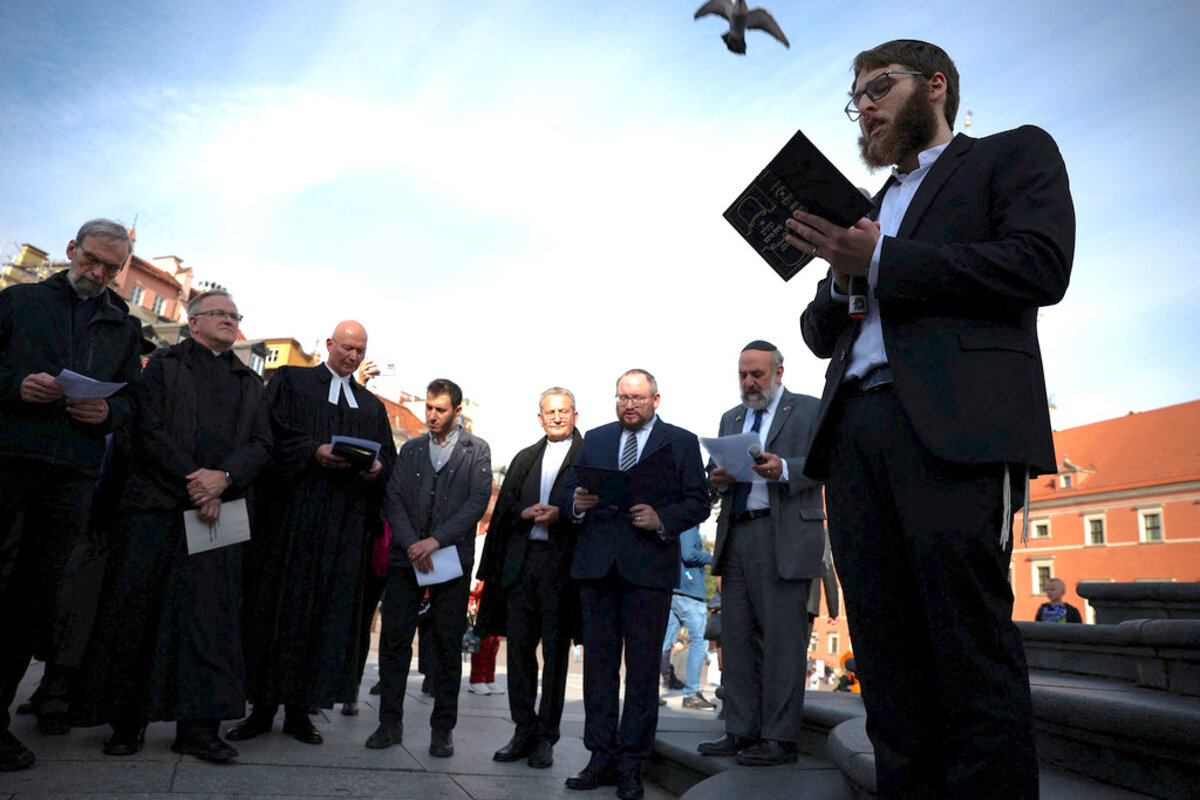
The hellish violence in Israel and Gaza has stirred many interfaith groups around the world – especially those of Jews and Muslims – to reach for a touch of heaven. Each in its own way has used dialogue, shared action, or prayer to heal the tense emotions around the war. One poignant response was a multireligious service on Friday in Poland, the country where all six Nazi death camps were built during the Holocaust.
More than a hundred people gathered in Warsaw’s Castle Square to pray for peace. The service was organized by the chief rabbi of Poland, Michael Schudrich, who has helped rebuild the Jewish community in Poland. “May the shared God of Jews, Christians, and Muslims be willing to hear our prayer,” read the invitation to the service.
During the Holocaust, one form of Jewish resistance was a reliance on prayer, or tefillah. Such moments of spirituality prevented the Nazis from breaking the faith of many Jews, as Victor Frankl, a Holocaust survivor, wrote in his book “Man’s Search for Meaning.”
Since the Soviet empire collapsed, Poland has built a tradition of interfaith harmony. The Roman Catholic Church, for example, has held an annual Day of Judaism to improve interfaith dialogue and remind Jews and Christians of their shared roots. Rabbi Schudrich has worked tirelessly to build bridges with leaders of other faiths.
In Israel this week, many Israeli Arabs and Bedouins worked with Jews to calm tensions or, in the case of the Bedouins, rescue Jews in areas hit by Hamas fighters. In the Asian nation of Azerbaijan, where the majority of people practice Islam, Muslims left thousands of roses at the Israeli Embassy in Baku.
In the United States, an Oct. 11 commentary in USA Today offered a specific prayer of petition to end the violence:
“We pray for the healthy return for all Israeli children, families and others taken hostage in the Gaza Strip as we pray for the cessation of collective punishment upon innocent Palestinian families,” wrote Rami Nashashibi, executive director of the Inner-City Muslim Action Network in Chicago, and Rabbi Andrea London of Beth Emet The Free Synagogue in Evanston, Illinois.
Prayer has a spiritual basis, as the late chief rabbi of Britain, Jonathan Sacks, often pointed out. He was a global leader in promoting religion as the solution for interreligious hate. In Judaism, Christianity, and Islam, he wrote, there is a spiritual force in the first book of the Bible when God says, “Let us make man in our image according to our likeness.”
If people of faith believe that, Rabbi Sacks stated, “the greatest religious challenge is: Can I see God’s image in someone who is not in my image – whose colour, class, culture or creed is different from mine?”

A Christian Science Perspective
Each weekday, the Monitor includes one clearly labeled religious article offering spiritual insight on contemporary issues, including the news. The publication – in its various forms – is produced for anyone who cares about the progress of the human endeavor around the world and seeks news reported with compassion, intelligence, and an essentially constructive lens. For many, that caring has religious roots. For many, it does not. The Monitor has always embraced both audiences. The Monitor is owned by a church – The First Church of Christ, Scientist, in Boston – whose founder was concerned with both the state of the world and the quality of available news.
God is comforting Her people
- Quick Read
- Read or Listen ( 3 Min. )
-
By Suzanne Smedley
No one – in the Middle East or elsewhere – is beyond the reach of the protecting, redeeming, strengthening light of God, infinite Life itself.
God is comforting Her people
In light of the brutal attack on Israel and its punishing response, many are seeking comfort in prayer. More than anyone, those still anxiously waiting for news about their loved ones’ safety and whereabouts, and those grieving their loss, need to feel God’s loving presence and almighty protection.
I thought of a Jewish family that my tour group crossed paths with several months ago in Israel. The family had fled from their home to escape sporadic rocket fire and was unsure if their home would still be there when they returned. I wondered, too, about a Palestinian friend who had essentially been stateless his whole life. All were gentle, peaceful individuals caught up in a cycle of fear, misunderstanding, and hatred. Were they safe?
During grievous times, prayers may sometimes seem futile and words hollow. But there are beautiful promises in the Bible that unburden the heavy heart and wing it with hope. For instance, in the book of the prophet Isaiah: “For thus saith the Lord.... As one whom his mother comforteth, so will I comfort you” (66:12, 13).
And in Psalms: “Whither shall I go from thy spirit? or whither shall I flee from thy presence? If I ascend up into heaven, thou art there: if I make my bed in hell, behold, thou art there. If I take the wings of the morning, and dwell in the uttermost parts of the sea; even there shall thy hand lead me, and thy right hand shall hold me. If I say, Surely the darkness shall cover me; even the night shall be light about me” (139:7-11).
What could be more comforting than to feel in the deepest recesses of our heart that not a single one of God’s children can be separated from Her love and saving power? There is no person or circumstance that is beyond the reach or help of God, infinite good. Wherever we are, God is, for we are at one with our divine Parent as the image, or spiritual reflection, of divine Love. Not even those seemingly caught in the web of hopelessness, fear, or hatred can be cut off from God’s redeeming love. God is here, now, guarding and guiding all of us.
Holding to the spiritual fact of everyone’s unbreakable unity, safety, and life in God brings light, hope, and strength to go forward.
As I prayed along these lines, I was reminded of a time when our family had lost contact with someone very dear to us who had been struggling with a challenging situation. We feared we might have lost them. All of us were praying for peace and comfort.
A family member later told me that as she was sitting and praying by a bay one day, a cormorant – a water bird common to the area – came into view. After paddling on the surface of the water for a few minutes, the bird suddenly dove into the deep and disappeared from sight.
In a flash of understanding, my family member saw that while our loved one was out of our sight, they had never left God’s loving care. Despite what we saw (or didn’t see) on the surface, this individual’s life was continuing uninterrupted because God, the creator of all that truly is, is Life. There was no place this individual could go or be taken to that would separate them from our loving Father-Mother, from Life itself. As God’s spiritual offspring, each one of us reflects divine Life, is the child of Life, and has an eternal life – an identity that is indestructible.
Whether we saw this individual again or not (and ultimately we did), nothing could change these spiritual facts. This was the comforting message that came to my family member through Christ – God’s powerful, universal message of truth and love – and replaced the darkness of fear and grief with light.
The discoverer of Christian Science, Mary Baker Eddy, gives this prayer of gratitude for God’s light and love:
“May the great Shepherd that ‘tempers the wind to the shorn lamb,’ and binds up the wounds of bleeding hearts, just comfort, encourage, and bless all who mourn.
“Father, we thank Thee that Thy light and Thy love reach earth, open the prison to them that are bound, console the innocent, and throw wide the gates of heaven” (“Miscellaneous Writings 1883-1896,” p. 275).
May the light and love of God be known and felt by all – in the Middle East and everywhere.

Viewfinder
Sailing celebration

A look ahead
You’ve come to the end of today’s issue. We wish you all the best this weekend. We will be following events in the Middle East and on Capitol Hill with an eye toward Monday’s Daily. We will also have a story on the Darién Gap – the thin ribbon of land that connects North and South America. A record 400,000 people have migrated across the gap so far this year, up from 250,000 last year. We look at some of the reasons the number keeps climbing – and the knock-on effects.




